|
The Exercise Prescription Template can be accessed from:
AAA Home
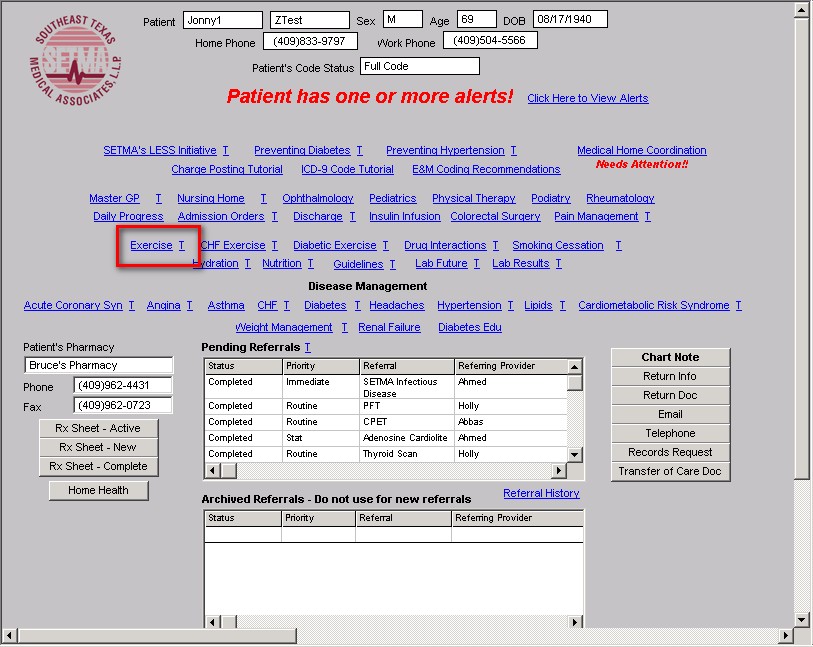
Main Tool Bar
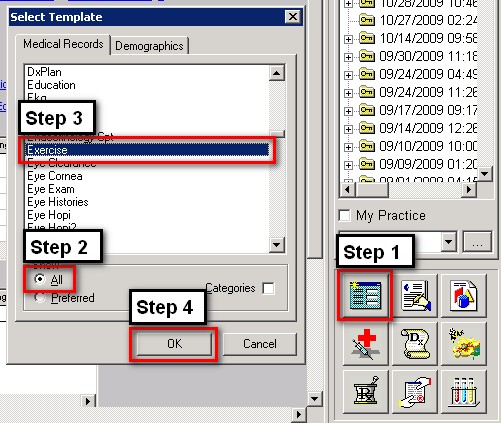
- When the Template button is clicked you will be presented with the preference list.
- If the Exercise Prescription Template is listed as one of your preferences, select it.
- If it is not one of your preferences, select the Demographics tab and then the All radio button and scroll down until you find it in the list. Then you may select the template by either double-clicking on the name or single click on the name (so that it is highlighted in blue) and then click the OK button.
NOTE: For more on how to set up your preferences, Click Here
Exercise Assessment
The foundation to health is physical activity regardless of age and/or state of one's health. Research has shown that when a healthcare provider discusses physical activity with a patient at every visit, that there is a significantly increased level of physical activity in the patient's life style. SETMA's Exercise Prescription, along with the disease specific exercise prescriptions for CHF and Diabetes, aid healthcare providers in the fulfillment of this element of quality healthcare.
Current Exercise Activity
This allows for the documentation of the patient's current structured activity in:
- Running/Walking/Jogging,
- Outdoor Cycling,
- Swimming,
- Tennis (Singes and Doubles),
- Rowing, and
- Golf
This is not to imply that these are the only valuable forms of exercise. In fact, it is possible to achieve health with the level of activity in one's routine work, gardening, house work, or other activities. However, the above six categories are the most common forms of activities which are done with health in mind.
When completing the exercise prescription, once the distance, when it applies, the duration of exercise and frequency are documented, the Calculate button displays the Aerobic Units per Session and the Aggregate Units per week. These aerobic units are based on the Cooper Clinic data which is published elsewhere.

Exercise Prescription
A prescription can be written for running/walking/jogging, outdoor cycling, swimming, tennis or rowing.
If running/walking/jogging is selected by clicking in the radio button next to that option, the following are automatically selected based on gender:
- Distance in miles
- Duration in minutes
- Times per week.
When the Calculate Button is clicked, the following are automatically displayed:
- Units per session
- Units per week
- Fitness Classification
The running/walking/jogging exercise prescription default numbers are based on gender-specific programs which result in a "good" fitness classification
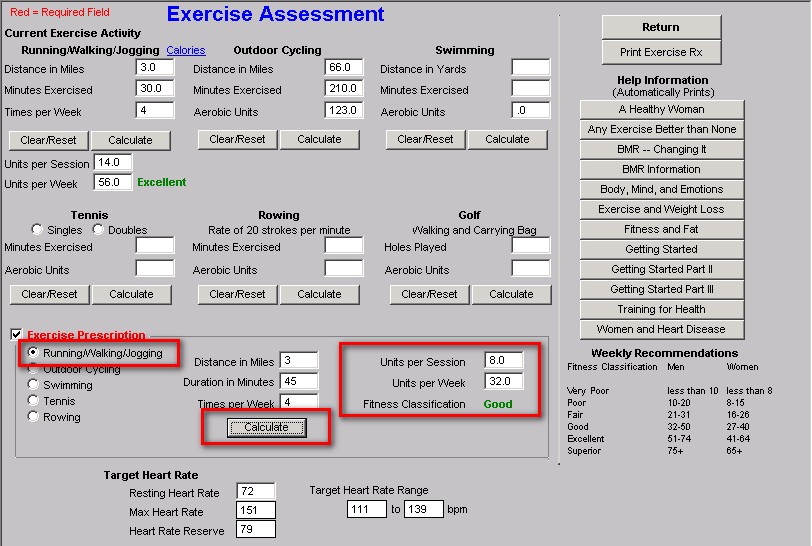
Target Heart Rate
Because the Exercise Prescription gives information on using the target heart rate as a measure of the level of physical activity, the following are automatically calculated and displayed based on the patients age and physical examination:
- Resting Heart Rate
- Max Heart Rate
- Heart Rate Reserve
- Target heart Rate Range
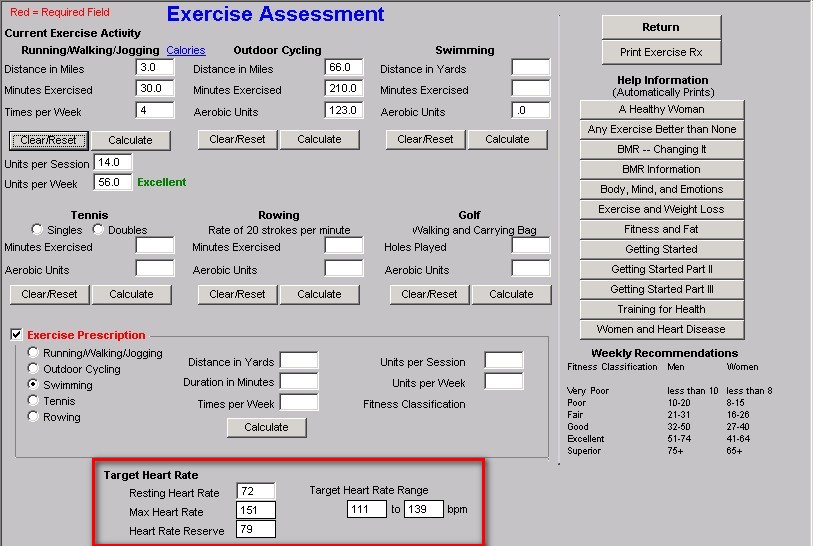
Once the above has been completed, the Print Exercise Rx button at the top right hand of the template should be depressed. This generates a note which is described below. This Exercise Prescription should be given to the patient at each visit. If the LESS Initiative is completed, this document will be a part of the LESS material which is given to the patient.
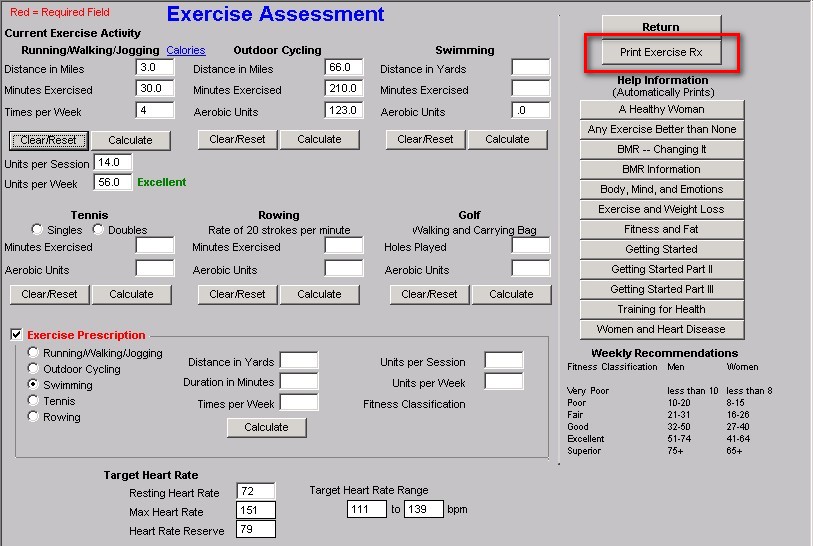
There is also a list of Help Information which will benefit the patient who is interesting in learning about the benefits of physical exercise:
- A Health Woman
- Any Exercise Better Than None
- BMR - Changing it
- BMR Information
- Body, Mind and Emotions
- Exercise and Weight Loss
- Fitness and Fat
- Getting Started Part II
- Getting Started Part III
- Training for Health
- Women and Heart Disease
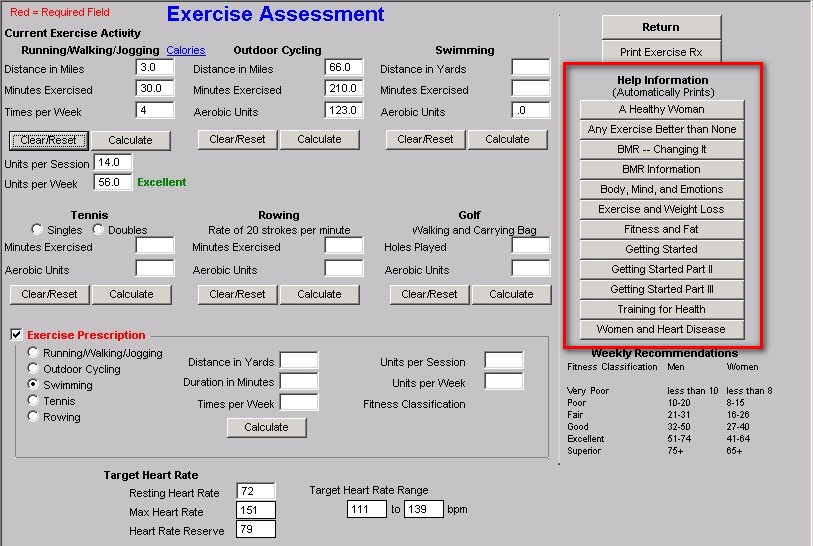
At the bottom right of the template are the Weekly Recommendations for Aerobic Units based on Fitness Classifications for Men and Women

Fitness Classification |
Men |
Women |
Very Poor |
Less than 10 |
Less than 8 |
Poor |
10-20 |
8-15 |
Fair |
21-31 |
16-26 |
Good |
32-50 |
27-40 |
Excellent |
61-74 |
41-64 |
Superior |
75+ |
65+ |
The running/walking/jogging exercise prescription default numbers are based on gender-specific programs which result in a "good" fitness classification
The Exercise Prescription Content
There are 17 parts to the exercise prescription. Below is a description and content of each part.
Part 1 -
At the beginning of the prescription, the following quote appears. This should be reviewed with the patients as it is a profound comment on the importance of fitness in health. It states:
""Those who think they have not time for bodily exercise will sooner or later have to find time for illness." - Edward Stanley, Earl of Derby (from Conduct of Life, address to Liverpool College, 20 December, 1873)
Part 2 --
Next a table with Cooper's Aerobic Units is reproduced for the patient's benefit:
Recommendations for Weekly Aerobic Units
Fitness Classification |
Men |
Women |
Very Poor |
Less than 10 |
Less than 8 |
Poor |
10-20 |
8-15 |
Fair |
21-31 |
16-26 |
Good |
32-50 |
27-40 |
Excellent |
51-74 |
41-64 |
Superior |
75+ |
65+ |
Part 3 --
The next section of the Exercise Prescription presents a discussion of the three categoris of exercise in which the patient should engage; it states:
Your exercise should include:
Strengthening of your muscles (upper and lower body) -- use weights that are a comfortable size for you and do multiple repetitions rather than one or two liftings of weights you can barely move. The object is to tone and strengthen your muscles, increasing your lean body mass, improving your basal metabolism rate, rather than building big muscles. For weight control, this is the most important part of your exercise regimen. Strengthening exercises should be done four to six days a week, rotating from upper to lower body muscles from day to day. Repeating lifting to fatigue without injury is the best way to gain lean body mass and muscle strength.
Stretching of your muscles -- nothing will contribute more to the decrease of injury than stretching. You should not stretch to the point of injury, but you will stretch to the point of discomfort. Once your muscle is stretched out do not stress it by bouncing against it or trying to go further. Hold the muscle in the stretched position for sixty seconds. Stretching should be an everyday exercise. It does not require any equipment, except possibly for an elastic band.
Striking of your muscles (jogging, walking, running, cycling, swimming, etc) -- this is where the capacity to use oxygen, particularly the heart muscle, is increased. This is called aerobic capacity. If you are contemplating a conditioning program, SETMA's cardiopulmonary physiology test is an excellent way to establish your baseline and to determine how you are progressing. Ask about it. Aerobic activities should be done at least three days a week and preferably five.
Part 4 --
Following this the fourth section of the exercise prescription details the "Recommended minimum exercise" which is automatically calculated for the patient based on age and gender.
Recommended Minumum Exercise
- Walking/Jogging/Running
- Distance: 3.0 miles
- Duration per Session: 50.0 minutes
- Aerobic Units per Session: 6.8 units
This recommended amount of exercise 4 times per week will give you a total of 27.2 aerobic units each week. This will place you in a "good" aerobic conditioning category.
Part 5 -
The Fifth section of the exercise prescriptions addresses the concept of 10,000 steps a day and gives the following information about its importance.
10,000 Steps a Day
The Amish and Activities of Daily Living
A study of Amish men and women was published in the journal Medicine and Science and Exercise in January, 2004. The result of a project at the University of Tennessee, the study documented that Amish men are six times more active than the average American. While the average American takes 2-3,000 steps a day; Amish men take an average of 18,425 steps a day and Amish women take an average of 14,196 steps a day. One Amish man took over 51,000 steps in a day, which is equivalent to walking 25 miles.
What is the result? The Amish have a 4% incidence of obesity and 26% were overweight as opposed to a 31% obesity and 64% overweight in the general American population. And, this is in spite of the very high-calorie, high-fat-content diet which the Amish typically consume.
Part 6 -
The sixth section of the exercise prescription discusses Activities of Daily living as Exercise.
Activities of Daily Living as Exercise
Can something as simple as walking further to get the mail or the newspaper make a difference in your health? Absolutely! In another study published in the May, 2004 issue of Medicine & Science and Exercise, the official journal of the American College of Sports Medicine, it was reported that middle-aged women who took at least 10,000 steps per day on average were much more likely to fall into recommended ranges for measures of body composition such as total body weight and body fat percentage. Conversely, inactive women those taking fewer than 6,000 steps per day were more likely to be overweight or obese and have higher waist circumferences, a strong predictor of increased risk of cardiovascular disease.
Middle-aged women who accumulate more daily steps have a more favorable body composition profile. This is the first study to specifically examine the relationship between average accumulated steps per day and body composition variables in women who are in their middle years. In the study, eighty women between the ages of 40 and 66 were first weighed and measured, then instructed to wear pedometers for one week and log the number of steps taken each day. They were asked to follow their typical work and leisure routines during the one-week period. Researchers classified the participants into groups of:
- Inactive (6,000 or fewer average daily steps),
- Somewhat active (6,000 9,999) and
- Active (10,000 or more)
They then analyzed body mass index (BMI), body fat, and waist and hip circumference. The study showed a significant inverse correlation between average steps and each of these measurements. On average, those in the active category had only 26 percent body fat and were within the recommended BMI range while those in the inactive group had a body fat percentage of 44 percent and fell well into the overweight category for BMI.
Researchers point out the public health implications of the evidence, particularly the apparent benefit of accumulating steps throughout the day. Although dietary intake is of equal importance, the investigators suggest that this evidence may eventually lead to the establishment of a standard volume of daily walking for middle-aged women that may help to prevent unhealthy weight gain.
These "step" recommendations are not complicated by heart rate monitors or by stop watches or distance measurements. They are simply a means of documenting that you are "moving."
Get a Pedometer (a device which documents how many steps you take in a day) and increase your activity to 10,000 steps a day. It works as well as "going to the track or to the gym.
Part 7 -
The seventh section of the Exercise prescription describes how the patient can increase their "steps per day." Often it is possible to do this rather than finding the time for structured exercise in the day. This section states:
Steps Per Day
Ways to increase steps per day:
- Park further away from buildings
- Take the stairs
- Walk to the store
- Take the long way to where you are going
- Mow your yard with a mower that you walk behind rather than ride
- Find excuses to go up and down the stairs at home rather than looking for ways to avoid steps
- Walk the golf course rather than ride
- Walk around to a colleague's office rather than calling
- Get out and walk into the post office rather than using the drive up window
- Schedule time each day for a 30-60 minute walk
Remember, the more you walk, the healthier you will be. And, if you decrease your calorie intake by 100 calories per day (that's an apple a day less intake) and increase your steps by 10% every two weeks, you will lose 20 pounds in a year without trying.
Part 8 -
The eight section of the Exercise Prescription discusses heart rate as a basis of judging one's exercise-for-fitness program. This section begins with a documentation of this patient's personal maximum heart rate, resting heart rate, heart rate reserve and Target heart rate range. It states:
Target Heart Rate
Your Maximum Heart Rate is 194 beats per minute.
Your Resting Heart Rate is 65 beats per minute.
Your Heart Rate Reserve is 129 beats per minute.
Your Target Heart Rate Range is 129 to 174 beats per minute.
The section continues with information about how to use the target heart rate in evaluating one's own exercise prescription.
To achieve a training effect, i.e., to improve your aerobic capacity, you should exercise so as to have your heart rate between the two values given above. You should not exceed the maximum heart rate without having had a thorough cardiac evaluation. In order to raise your heart rate, you will need to begin your exercise slowly and then gradually increase your speed and/or distance in order to achieve your "target heart rate range." Obviously, there is some incremental training effect the higher your heart rate, but the greatest benefit is achieved by going from a sedentary life style to a regular exercise program within the "target heart rate range" even if it is at the lower end.
As you exercise within your "target heart rate range," you will be strengthening your heart, your muscles and improving your breathing capacity. Your goal should be to exercise for 30-60 minutes 3-5 times a week with your heart rate in your "target heart rate range."
The aerobic points which you achieve each week will help you judge your distance and speed. Your "target heart rate range" will help you judge the benefit your cardiovascular system is realizing from your effort.
Part 9 --
The ninth section of the exercise prescription describes how the patient can determine the "exercise stress level," of their exercise program.
Exercise Stress Level
I would also like for you to report how "stressful" your exercise is by the following scale.
During the exercise you are to rate your perception of exertion. Use this scale where 6 means no exertion at all and 20 means a totally maximum effort. The 13 on the scale is a somewhat heavy exercise but capable of being performed at steady state (i.e., anaerobic threshold). When at a level of 17 the effort level requires you to push yourself hard even though it is possible to continue for some time.
Try to appraise the feeling of exertion as honestly as possible. Do not underestimate nor overestimate it. It is of no value to underestimate the level to produce an impression of being "brave" or "tough". Your own feeling of effort and exertion is all that is of interest. Look at the scale and wordings and decide on the word that best describes your effort level and the number alternative associated with that description.
Part 10 -
Section 10 of the exercise prescription describes a rating scale of the stress level experience by your exercise program. It is called the Borg's Ratings of Perceived Exertions (RPE)
Borg's Ratings of Perceived Exertion (RPE)
6 |
No exertion at all |
7-8 |
Extremely light (very, very light) |
9-10 |
Very light (warm-up/recovery) |
11 |
Light |
12-13 |
Moderate |
14-15 |
Hard |
16-17 |
Very hard |
18-19 |
Extremely hard |
20 |
Maximum all-out effort with absolutely nothing being held in reserve |
Part 11 -
The eleventh section of the exercise prescription defines the "anaerobic threshold" and gives information as to why it is important to exercise planning. It states:
Anaerobic Threshold
It is useful to note that the anaerobic threshold will typically be found in the 12-15 levels and most often around the 13. Remember, the anaerobic threshold is the point at which your body's energy needs are no longer met by oxygen consumption and you begin to produce energy by the metabolism of Pyruvate into Lactate. The anaerobic threshold will vary from individual to individual depending on their conditioning. If an individual is poorly conditioned, the anaerobic threshold may be reached at as low as 50% of the maximum heart rate. If they are athletically fit, the anaerobic threshold may be reached at as high as 90% or higher of the maximum heart rate.
Remember, it is important not only to stress your heart and leg muscles but also your tendons and ligaments by stretching and all of your muscles by targeted exercise for each muscle group. There is no "pill," "prescription," or "procedure" which can be given to you which will do you as much good as exercise. Get started and keep going. Good luck."
Part 12 -
The twelfth section of the exercise prescription discusses another concept about exercise for fitness which is the "wellness continuum of conditioning."
Wellness Continuum of Conditioning
The wellness continuum consists of three areas of physical well-being
- health,
- fitness, and
- performance.
We need to keep in mind that we're not all going to have the same goals. This is why your friend, who's a veteran marathoner, might complain about what kind of "shape" he or she is in, while you would kill to look the way they do and be so fit and healthy. The health area covers those training zones that promote health but don't primarily improve physical fitness and certainly not performance.
- To measure improvements in health, we seek positive changes in blood pressure, body fat, cholesterol, etc.
- To measure improvements in fitness, however, it's positive changes in oxygen utilization, lactate concentrations and heart rate points we're looking for.
- To measure improvements in performance, positive changes in completion times, accuracy of movement skill, mental attitude, and other indices are used.
Part 13 -
Section thirteen of the exercise prescription builds on the "wellness continuum of conditioning" concept by discussing the "five heart zones" associated with that concept.
Established Zones
Using the knowledge above, we can establish zones of exercise which will either improve our health, fitness or performance. There are five zones.
The Wellness Continuum and the Five Heart Zones
Zone |
Name |
Perceived Exertion Difficulty |
Heart Rate Range |
1 |
Healthy Heart Zone |
Perceived Exertion is 10-11 |
97 to 116 bpm - Health Zone |
2 |
Temperate Zone |
Perceived Exertion is 12-13 |
117 to 135 bpm |
3 |
Aerobic Zone |
Perceived Exertion is 14-15 |
136 to 155 bpm - Fitness Zone |
4 |
Threshold Zone |
Perceived Exercise is 16-17 |
156 to 174 bpm |
5 |
Redline Zone |
Perceived Exertion is 18-20 |
175 to 194 bpm - Performance Zone |
(see Borg's scale above) |
Zones use time, not distance, as their measurement tool. That is, the amount of time you spend in the zone is the way you measure your workout, not in miles run, or the number of strokes per minute cycled or rowed. This measurement is called "time in zone" and is measured in the minutes that you spend in each zone. For example, one day you decide to run for 30 minutes in the Aerobic zone; the following day you might choose to walk for 50 minutes in your Fat Burning zone. Varying your workouts, both in activity and zone, allows you to get multiple benefits from your training.
At the lower zones--or "cruise" zones as they are sometimes called--you can train in zone for longer periods of time. But, as you move up to higher intensity zones, you need to decrease the amount of time that you spend in that zone, particularly in the top two, the Anaerobic and Redline zones. This simply makes sense--you can walk farther than you can sprint, and overdoing it is nearly a guarantee of injuries or burnout.
Your five heart rate zones are specific to your maximum heart rate, not anybody else's. The numbers given above are for you, not someone else. With two runners, each maintaining a heart rate of 160 bpm, one might well be in their Threshold Zone and the other may be in their Temperate Zone. It's all relative.
Part 14 -
The fourteenth section of the exercise prescription relates exercise zones to calorie consumption which will be helpful if you are using exercise as a means of controlling or reducing your weight. Generally, those who are successful in attaining and retaining their ideal weight or their desired weight, will do so with structured aerobic exercise.
Each heart zone burns a different number of calories per minute based on how fit you are.
Zone 5 |
20+ calories per minute |
Zone 4 |
17-20 calories per minute |
Zone 3 |
12-17 calories per minute |
Zone 2 |
7-12 calories per minute |
Zone 1 |
3-7 calories per minute |
You'll burn a different ratio of fat to carbohydrates in each of the heart zones.
One of the foundation principles of heart zone training is that we need to train in different heart zones to get different benefits. There is no one "training zone". There is no one "target zone". Those are old training concepts that have been shown not to fit with the way the body really trains. In fact, there are multiple zones that provide multiple and varied benefits. Train in the zones that most fit your goals: health, fitness or performance.
Part 15 -
Section fifteen expands the concept of the heart rate zones and gives details about each.
Heart Rate Zones
Zone 1 (50 - 60% of MHR) - The lowest level you can exercise in and still increase fitness levels. For beginners or people who have not exercised for a long period of time. This zone can be for just improving your overall health. It can also be a good recovery zone for people who are over-training and need to take a break. This mode is also good for people who want to lose weight as the main source of fuel used by the body is fat stores.
Zone 2 (60 - 70% of MHR) - This is the zone where the heart begins to benefit. Training in this zone will begin improve your hearts ability to pump blood and improve the muscle cells ability to utilize oxygen. In this zone stored body fat is the primary source of energy utilized hence this zone is referred to as the weight management zone. This is a good zone for long slow distance exercise as the body becomes more efficient at feeding the working muscles more efficiently especially with fat as the main fuel source.
Zone 3 (70 - 80% of MHR) - This zone is the most effective for overall cardiovascular fitness and is often called the "aerobic zone" or "target heart rate zone". This is the optimal zone to workout in to increase your cardio-respiratory capacity or the bodies ability to transport oxygenated blood to the muscle cells and carbon dioxide away from the cells. After a while you will be able to cover more distance during workouts in less time. Your body will burn less glucose and more stored fat as fuel thereby working more efficiently. This zone is also effective for increasing overall muscle strength.
Zone 4 (80 - 90% of MHR)(85-90%= Anaerobic Threshold) - this level is where you cross over from aerobic training to anaerobic training which is called the anaerobic threshold or AT. This is the point where the body cannot effectively remove lactic Acid from the working muscles quickly enough. Lactic Acid is a by product of glycogen consumption by the working muscles. This zone is primarily for people who want to increase their performance levels. You would characterize this zone as hard. During this zone your muscles are tired, your breathing is heavy and your fatigued. The benefit of training in this zone is you can increase your bodies ability to tolerate and deal with lactic acid for a longer period of time as the enzymes in your muscles responsible for anaerobic metabolism are increased. For competitors it is good to know your anaerobic threshold as many fit athletes can compete at or about their anaerobic threshold.
Zone 5 (90 - 100% of MHR)(VO2 Max) - You will only be able to train in this zone for short periods of time. You should not train at this level unless you are very fit. In this zone lactic acid develops very quickly as you are operating with oxygen debt to the muscles The value of training in this zone is you can increase your fast twitch muscle fibers which increase speed. You will not be able to stay at this level very long and should be used in intervals or sprinting work at the track.AC
Part 16 --
Section sixteen of the exercise prescription gives information about how to get started with your exercise prescription.
Deciding Where to Start and How
If you are a beginner with the goal of improving overall fitness, losing weight or reducing stress, exercise at 50-60 percent of your maximum heart rate.
- If you already exercise regularly but are aiming to lose body fat, exercise at 60-70 percent of maximum heart rate. Build up to a work out of an hours continuous exercise.
- If your goal is to improve aerobic capacity or athletic performance, exercise at 70-80 percent of your maximum heart rate.
- Competitive athletes may need to add interval training sessions during the week by training at 80-90 percent of maximum heart rate. This high intensity exercise helps train muscles to handle lactic acid.
Train sparingly at higher heart rates. Exercising regularly at a heart rate intensity that is too high does not produce additional aerobic benefits and increases the possibility of an athletic injury. Interval training and anaerobic threshold workouts require a high degree of fitness, and is not necessary for general fitness training.
Once you determine your individual training zones, you can easily program them into your heart rate monitor. Your monitor will notify you with a beep if you are exercising above or below the pre-programmed zones. Many heart monitor models record time spent in your heart rate target zone. You can then evaluate your exercise after each session and adjust your intensity if needed. Recording heart rate also allows you to monitor your fitness improvements over time.
Part 17 -
Section seventeen of the exercise prescription gives tips about effective training.
Tips on Effective Training
Warm up & cool down. Always do a slow warm up of 5-10 minutes, followed by some gentle stretching. Then gradually climb into the target range you have set. End every workout with a 5-10 minute cool down, again followed by some gentle stretching. The importance of this can not be over emphasized. Studies have shown that people who warm up and cool down adequately have fewer athletic injuries.
Type of Exercise. Choose activities that use large muscle groups and which are continuous in nature. Some good examples are walking, swimming, running, aerobic dance, stair climbing machines, ski machines, treadmills, cycling or exercise bikes. Feel free to include more than one activity - cycle one day, swim the next, and do aerobics on the third. This is called Cross Training and helps exercise all muscle groups, reduces boredom and keeps motivation high.
Frequency of exercise. Exercise in the target range that you have set at least 3-5 times per week, with no more than 48 hours between sessions. Even on 'rest days' gentle exercise such as a leisurely walk can be beneficial.
Intensity of exercise. Select an exercise intensity zone that is both within your capability and in which you can achieve consistency. Studies show that people who exercise at too high an intensity, especially in the initial stages of their program, drop out sooner, have more injuries, and tend to develop a negative impression towards exercise in general. If necessary start in a low exercise intensity zone and build up.
Time exercising. Aim for 20-60 minutes of continuous exercise in your target zone each session. If you are unable to exercise for 20 minutes initially, slow down and gradually build up to this.
Before you begin your exercise program, get an assessment of your overall fitness level. You must get clearance from your doctor that it is safe for you to exercise.
Conclusion:
Information will not make you fit nor will it help you lose weight. It only helps you make plans for fitness and/or weight reduction. To be successful, you must carry out those plans consistently over a lifetime.
Always encourage your patient to start over immediately if they fail and to recognize that something is better than nothing. Also, remind them that it is better to have tried and to have failed that not to have ever started.
|